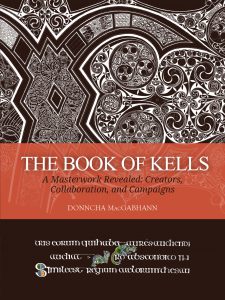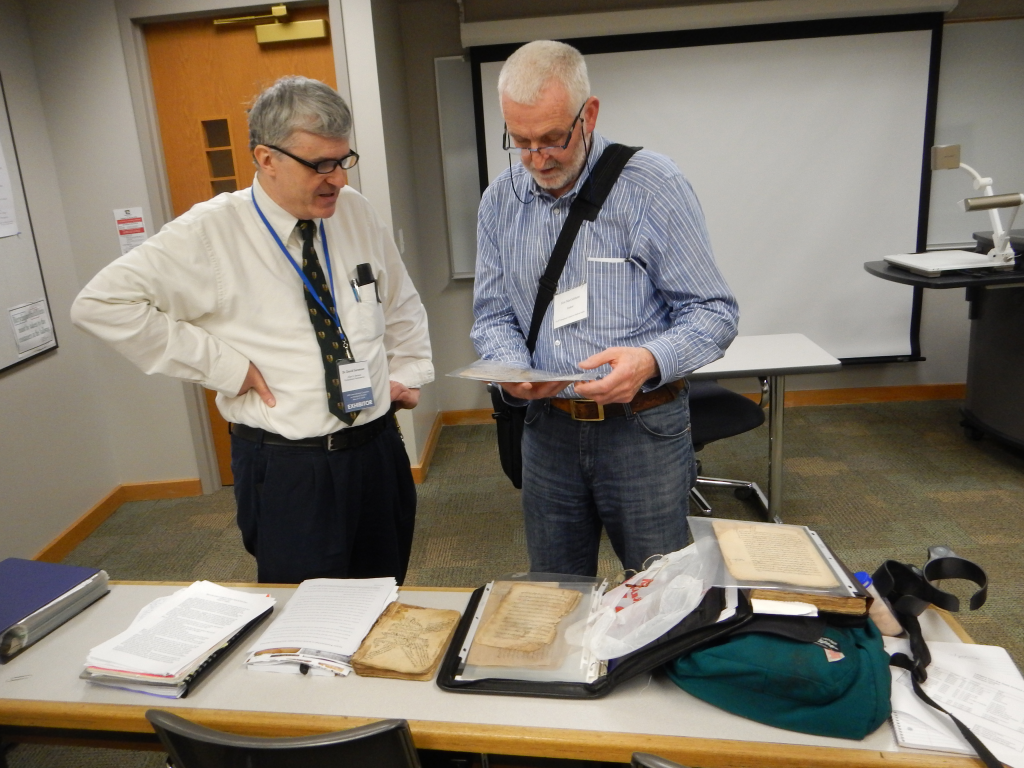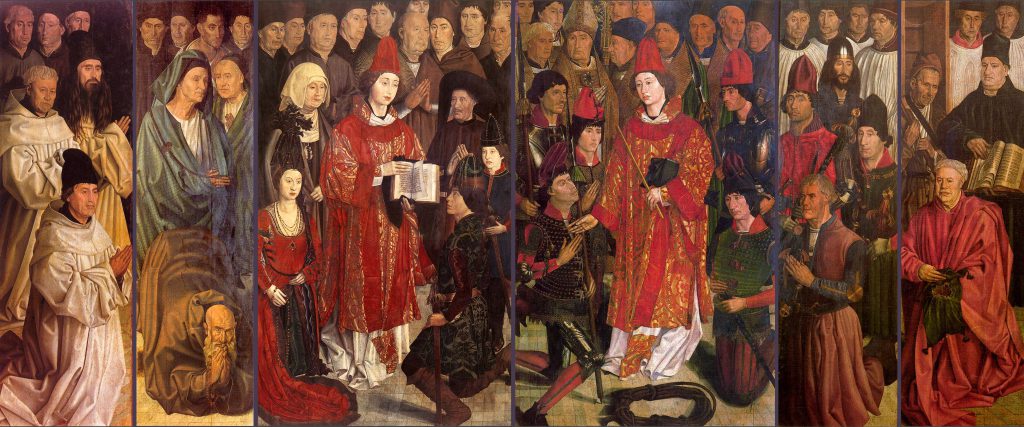Donncha MacGabhann on the Making of “The Book of Kells”
November 1, 2022 in Announcements, Manuscript Studies, Research Group Speaks (The Series)
The Research Group Speaks
Episode 9
Saturday 19 November 2022 online
“The Book of Kells: A Masterwork Revealed”

Donncha MacGabhann at work on his close study of letter forms in the Book of Kells. Photograph via his publisher, Sidestone Press (Leiden 2022)
– An informal Interview/Conversation with Donncha MacGabhann, Associate of the RGME, about his newly published book
[Posted on 31 October 2022 by Mildred Budny, with updates]
For Episode 9 in the online series of The Research Group Speaks, we present an informal Conversation or Interview with the author about his new book on The Book of Kells: The Making of a Masterwork (Leiden, 2022).
The Book has emerged from Donncha’s detailed study for the Ph. D. dissertation (London, 2016), as well as his own experience as an artist. For our Episode, he will tell us about the making of his Book on the making of the Book of Kells . . .
To Register for the event, see Below.
The Book of Kells
One of the chief treasures of the Library of Trinity College Dublin (since at least 1661), and the subject of widespread fame, the Book of Kells might need no introduction.

The Long Room of the Old Library, Trinity College Dublin, seen from the entrance (2015). Photo by DAVID ILIFF. License: CC BY-SA 3.0.
- Dublin
, Trinity College Library, MS A. I. [58]
, the Codex Cennanensis, now comprising 340 vellum folios, bound (since 1953) in four volumes, one for each Gospel.
The online Library catalogue offers concise descriptions. About the contents, for example, some essential facts:
The Book of Kells (Leabhar Cheanannais, Trinity College Dublin MS 58) contains the four Gospels in Latin based on the Vulgate text which St Jerome [circa 342 – circa 347 – 30 September 420] completed in 384AD, intermixed with readings from the earlier Old Latin translation. The gospel texts are prefaced by other texts, including “canon tables”, or concordances of gospel passages common to two or more the Evangelists; summaries of the gospel narratives (Breves causae); and prefaces characterizing the Evangelists (Argumenta).
A different approach can be found, for example, in a concise guide for the curious:
- Ten Things You Should Know about the Book of Kells, or the Book of Columba
— along with, say, 10 Things You Should Know About The Gutenberg Bible.
Have a Look:
- The Book itself, in online facsimile: Book of Kells. IE TCD MS 58
- Its introduction: Book of Kells
For my part, one of the principal highlights — not the only one — of my long study of early medieval manuscripts from the British Isles, their companions, and their contexts (for example, British Library, Manuscript Royal 1 E. vi: The Anatomy of an Anglo-Saxon Bible Fragment and Deciphering the Art of Interlace), was the opportunity to examine directly, turning the pages, two volumes of the Book of Kells. That experience, over some days, augmented and amplified the observations of the volumes on display, along with other treasures, in the imposing Long Hall of the Library. The opportunity, with permission, to look at the Book itself took place in the Director’s office, with the clear light of natural light during an unusually dry summer with cloudless skies. Memorable indeed. #turnedthepages.
A few years later, while part of the Book came on tour among the travelling Treasures of Ireland (1982 and 1983), I could see part of it again, in museums in Paris and in New York, under subdued light and behind the glass case. Different views, same astonishing monument.
Very, very many people can say that they have seen the Book of Kells. Attracted by its fame, visitors to the Library, where it has been displayed since the nineteenth century, number on average some 500,000 each year. On her visit, Queen Victoria (1819–1901) was encouraged to sign it — as an extraordinary form of ‘Visitors’ Book’.
Over the centuries, many have commented upon the Book of Kells. They include scholars, historians, palaeographers, art historians, authors, artists, and others. Some observers have taken inspiration from it in multiple ways, verbal and visual, to form creative works of their own, ranging from, say, Finnegans Wake (1939) to The Secret of Kells (2009).
Donncha MacGabhann’s long-term study, considering detail after detail of script and ornament, of the original Book of Kells as a whole brings fresh views of its process of creation, as the scribes worked their way across the pages and into an accomplishment truly worthy of curiosity, admiration, and wonder. Aware of Donncha’s study for some years, I have looked forward to his book revealing the results of his research.
Donncha MacGabhann’s Book on Kells
About Donncha, see, for example,
His Book, just about to appear in print, examines
- The Book of Kells. A Masterwork Revealed: Creators, Collaboration, and Campaigns
(Leiden: Sidestone Press, 2022).
Paperback ISBN: 9789464261226 | Hardback ISBN: 9789464261233 |
Ebook only (pdf) and Ebook (read online for free)Format: 210x280mm | 324 pp. | Language: English | 11 illus. (bw) | 109 illus. (fc) |
Keywords: Book of Kells; insular manuscripts; insular art; palaeography; Early Medieval gospel books; Early Medieval Christianity; art history; calligraphy |
From the publisher comes this description:

Front Cover of Donncha MacGabhann, “The Book of Kells: A Masterwork Revealed” (2022).
Sublime calligraphy, marvelous art, and amazing initials, have charmed and captivated the audience of the Book of Kells for over twelve hundred years. This remarkable illuminated Gospel book attracts the attention of scholars as well as those more generally interested in the fabulous artifacts of the past.
Everybody knows it was made by an extensive team of scribes and artists. Donncha MacGabhann knew that too. However, he was certain that a thorough examination could clearly identify the various contributions of its creators.
His life and work as an artist and teacher inspired the belief that a close visual study could solve some of its enduring puzzles. The deeper he delved, the more he was convinced that Kells is entirely the work of two individuals. This evolved into a novel paradigm through which he came to know and understand the manuscript. Following years of meticulous research, this book tells the story of Kells’ two Masters and their collaboration to create a Gospel book of unprecedented magnificence. Most poignantly, it reveals the struggle of the lone survivor of the two-man team to attempt the completion of their magnum opus.
The most important outcomes of this book go far beyond the simple attribution of work to different hands. Much more significantly, it affords insights into the imagination which inspired its creators, especially the unique vision of Kells’ great Scribe-Artist. Collectively, these new perspectives reveal a previously unknown ‘Book of Kells, ‘ one which, as it were, has remained hidden in plain sight.
Descriptions of Donncha’s book and its contents, approach, discoveries, and significance appear among various booksellers, as with
The Process of Research and Discovery
In Donncha’s own words, as the research unfolded:

Dublin, Trinity College, MS A. 1 (58), folio 34r. Chi-Rho Initial Page (Matthew 1:18). Image via Wikimedia Commons; Public Domain in the US.
Key research interests include Insular palaeography and illumination. My current focus is to extend and develop the research which was the basis for my PhD (2016). My thesis investigation was concentrated on the makers and the making of The Book of Kells. This provides the first in-depth and comprehensive analysis of both the illumination and the scribal work in the manuscript.
My research was significantly informed by the experience gained in my career as an Artist and Art-Teacher. Complementary to the more traditional modes of academic enquiry this enabled me to draw on a skill-set which was integral to the development of my research methodology. This methodology of close visual analysis was central to my approach.
My immediate aim is communicate, through publication, the results of my doctoral research to the scholarly community. It is also my intention to extend the application of the methodology developed in my thesis to a number of other Insular manuscripts and to consider the implications of the revision of hands in the material culture of the Insular world more broadly. (Donncha MacGabhann)
Donncha’s Ph.D. dissertation is freely available for download:
- The making of the Book of Kells: two Masters and two Campaigns (Doctoral thesis, University of London, 2016) https://sas-space.sas.ac.uk/
6920/ (via Creative Commons)
Its Abstract:
This thesis investigates the number of individuals involved in the making of the Book of Kells. It demonstrates that only two individuals, identified as the Scribe-Artist and the Master-Artist, were involved in its creation. It also demonstrates that the script is the work of a single individual – the Scribe-Artist. More specific questions are answered regarding the working relationships between the book’s creators and the sequence of production. This thesis also demonstrates that the manuscript was created over two separate campaigns of work. The comprehensive nature of this study focuses on all aspects of the manuscript including, script, initials, display-lettering, decoration and illumination.

Detail from Front Cover of Donncha MacGabhann, “The Book of Kells: A Masterwork Revealed” (2022): Black-and-white reproduction by the author of the ornamented center of the Chi-Rho Initial Page (Dublin, Trinity College, MS 58, folio 34r).
Previews
We met Donncha when he spoke for the RMGE about a facet of the Ph.D. research on the manuscript for one of our Sessions at the 49th International Congress on Medieval Studies (Kalamazoo, Michigan, May 2014). The Session considered “Individual Style or House Style? Assessing Scribal Contributions, Artistic Production, and Creative Achievements”.
Donncha’s paper examined the scribal uses of two forms or grades of late-antique and early-medieval script, Half-Uncial and Uncial, for the letter a at line-endings, where options for compression and variation could call for choice and artistic expression.
Half-Uncial a and Uncial a at Line-Ends:
The Division of Hands in the Book of Kells
and an Insight
into the ‘Calligraphic Imagination’ Evident in the Script
The abstract for Donncha’s paper appears on our website: MacGabhann 2014 Congress.
At the Congress, although we had corresponded earlier, we could meet Donncha, learn about his careful studies, his approaches to the creation and understanding of forms of the written word, and his observations about the original materials, in manuscript and in print, offered for display at some of our sessions.

David Sorenson and Donnach MacGabhann examine manuscript materials after the RGME Writing Materials Session at the 2014 Congress. Photography by Mildred Budny.
Several papers published in the course of the research spell out the methodological approach. For example,
Palaeographer Erika Eisenlohr has stated that ‘the similarity or dissimilarity of hands in Kells has so far mainly been based on more general impressions of the scripts’ (1994). My research attempts a more comprehensive investigation of the evidence including illuminated pages, script and illumination of the canon tables, mise-en-page, punctuation, display script, decorated initials, regular script and elaborations to the script.
— Donncha MacGabhann, Abstract for “The et-ligature in the Book of Kells (Revealing the ‘calligraphic imagination’ of its great scribe)” (2017), in Conor Newman, Mags Manion, and Fiona Gavin, eds., Islands in a Global Context. Proceedings of the seventh Conference on Insular Art, held at the National University of Ireland, Galway, 16–20 July, 2014 (Dublin, 2017), pp. 138–48.
The Script(s) of Kells
Discussion of the varieties of script, ornamented letter forms, and other forms of ornament in the Book of Kells continues in its own right over time. It also forms, or should form, an integral part in an ongoing consideration of many features of the book, both individually and in combination. That is: the various texts (Gospel texts , their companion texts including prefaces, summaries, and canon tables with numerals and titles, as well as added texts such as Irish charters), illustrations, canon arcades and frameworks, scribal characteristics, writing materials (animal skins, inks, pigments, their binding agents, traces of layout marks, and so on), layers of accretion, condition, sewing patterns, binding history, library history, layout, design, artistry, and more.
Many features figure, to varying degrees, in assessments of the likely place and date of production of the manuscript. Those assessments may remain open to exploration and refinement, as research advances, methods of exploration expand, attitudes may direct, and discoveries emerge.
Reproductions, Photographic and Pre-Photographic

Poster, designed by the RGME, for a lecture on 19 November 2020. Image: Photograph by Mildred Budny of Boulogne-sur-mer, Bibliothèque des Annonciades, MS 11, reproduced by permission.
With restricted access nowadays to the treasured original, and with the proliferation of digital means of reproduction and dissemination, close study of the multiple features of the manuscript would mostly rest upon consultation of such reproductions, however high in quality or ‘fidelity’. That those reproductive materials would, in no small measure, determine, affect, or direct the nature of the forms of study — as well as, it may be, the interpretations of that (indirect) evidence — should be evident.
Such factors in the study of manuscripts under current, prevailing, conditions in the age of photographic reproduction and the age of the internet remain a subject of considerable interest for the Research Group on Manuscript Evidence. For example:
- Mildred Budny, “No Snap Decisions: Challenges of Manuscript Photography”. Paper delivered at the Session on “Imaging Manuscripts for the Twenty-First Century: Photographs and Beyond” (1994), sponsored by the RGME at the 1994 International Congress on Medieval Studies.
Published, with its Abstract, Text, and Images, here. - “Manuscripts versus Photography: Image and Imago in a Digital Age”. Lecture for the Program in Medieval Studies, Princeton University (19 November 2010).
Our events continue to consider such factors of manuscript studies, whether as, perhaps, part-and-parcel, bread-and-butter, or meat-and-potatoes. That is, as Food for Thought.
As always, our interest in the processes of production and the people behind the books, keenly explored in cases of the medieval objects, extends also to the processes which underpin, sustain, and shape the studies themselves of those materials. These interests are manifest in many RGME activities, as with continuing explorations of relationships between “Manuscripts and Photography” in Seminars, Workshops, Conference Sessions, and Symposia; and in Episodes of our series wherein The Research Group Speaks. On such occasions, we might have opportunity to hear the authors of close studies of manuscripts or other materials speak about the origins, progress, and processes of their research, as well as its results. Such is the case for this Episode with Donncha MacGabhann, as his new book, long in the making, reaches publication.
Drawings of elements in the Book of Kells — as appear among Donncha’s figures — belong to a venerable tradition which reaches back to pre-photographic means of reproduction. Notable examples in that tradition include images from the manuscript carefully prepared by the observant entymologist and antiquarian John Obadiah Westwood (1805–1893). Examples appear in these of Westwood’s publications:
- Palaeographia sacra pictoria: Being a series of illustrations of the ancient versions of the Bible , copied from illuminated manuscripts, executed between the fourth and sixteenth centuries (London, 1845)
- Facsimiles of Anglo-Saxon and Irish Manuscripts (London, 1868)
Also, in excerpts: Facsimiles of Anglo-Saxon and Irish Manuscripts (London, 1868)
Close examination fostered by line-by-line reproduction, from one surface to another, may develop a keen awareness of specific details, in much the same way that detailed verbal descriptions can do, as with a catalogue or ‘inventory’ of features within a manuscript (or other monument). I myself learned the lasting value of preparing such descriptions — from the originals, aided by my photographic reproductions including macro-photography — for features of manuscripts in the Illustrated Catalogue, one of the co-publications of the Research Group on Manuscript Evidence.
From observations of the evidence, by various means and methods, the interpretations may follow, redirect, or revise.
In the new book, the choice of methodology of palaeographical examination, centered upon photographic reproductions and drawings, focuses upon excerpts of specimen letters and initials. Arrayed on these pages (printed or digital) in groups or rows of related letter-forms, the specimens stand removed or isolated from the ebb-and-flow of their naturally-occurring lines and columns of running texts upon their pages, and their openings, across the unfolding of the original book as a whole.
Mostly at a distance perforce from that original (even when viewed through the glass case of its exhibited pages), and very exceptionally in a direct encounter, we might find ways variously to imagine, to ‘reconstruct’, or to recollect, the process of turning its very pages and sensing the feel of the width of its leaves as their edges are turned.
Donncha’s Book on The Book of Kells
in our Episode for 19 November 2022
The publication of Donncha MacGabhann’s book is expected on 31 October 2022. The book can be ordered in print and pdf forms from the publisher and other booksellers. From the publisher’s website, it can be read online free of charge. See:
Episode 9 in the online series of “The Research Group Speaks” is planned for Saturday 19 November 2022, via Zoom, at 12 pm EST (GMT – 5) for about 1 1/2 hours, with discussion and Q&A. You are welcome to join us.
Registration for the Episode
If you wish to attend, please register here:
If you have questions or issues with the registration process, please contact director@manuscriptevidence.org.
Future Episodes
Future Episodes are planned. See
Suggestion Box
Please leave your Comments or questions here, Contact Us, or visit
- our FaceBook Page
- our Twitter Feed (@rgme_mss)
- our Blog on Manuscript Studies and its Contents List
Donations and contributions, in funds or in kind, are welcome and easy to give. See Contributions and Donations.
We look forward to hearing from you.

Lisbon, Museu Nacional de Arte Antiga: The mid 15th-century Saint Vincent Panels, attributed to Nuno Gonçalves. Image (https://upload.wikimedia.org/wikipedia/commons/3/3a/Nuno_Gon%C3%A7alves._Paineis_de_S%C3%A3o_Vicente_de_Fora.jpg) via Creative Commons.
*****

Front Cover of Donncha MacGabhann, “The Book of Kells: A Masterwork Revealed” (2022).
*****
